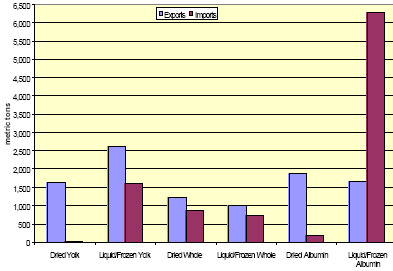



International Egg and Poultry Review
By the USDA's Agricultural Marketing Service - This is a weekly report looking at international developments concerning the poultry industry, this week following the latest news in the Avian Influenza outbreak.
Avian Influenza in Asia
The outbreak of avian influenza in major exporting countries in Asia, like Thailand and China, has opened opportunities for other countries to increase export markets.
Argentina has increased chicken meat exports from 15,637 in 1999 to 27,389 in 2002, an increase of 75 percent. As a percent of production, exports were fairly stable, from 2 percent in 1999 to 3 percent in 2003.
Australia's exports grew 22 percent from 1999 to 2002 and production grew 20 percent. Exports as a percent of production were stable at 2 percent. South Africa is the largest export market, taking 40 percent of all shipments. Hong Kong accounts for 20 percent of exports, followed by China with 6 percent and Sri Lanka with 5 percent.
Chile signed a free trade agreement with South Korea in 2002, which opened the Korean market. Chile has already increased chicken exports to the European Union after signing a Free Trade Agreement with the EU. Chile also has veterinary licenses to export to Hong Kong. In 2002 Chile had an outbreak of avian influenza which cut sharply into exports that year. Exports in 2003 were expected to rebound.

The Philippines exported less than one percent of chicken meat production in 2002. Imports were very light, consisting of just over one percent of domestic consumption. Although the Philippines
would like to increase exports, they can't expand production quickly enough to take advantage of the current situation. The Philippines Agriculture Secretary wants to keep domestic poultry in the country to ensure the food security of Filipinos.
India has almost doubled production from 1999 to 2003, climbing 95 percent. Exports increased dramatically, from 26 metric tons in 1999 to 450 metric tons in 2002. India ranked sixth in poultry production in 2002, behind the United States, Brazil, the European Union, China, and Mexico. India exports to the Middle East.
Sources: USDA/FAS and ERS, FAO, various news stories
Temporary Trade Restrictions for U.S. Poultry
A strain of the H7 avian influenza was detected in a small flock of chickens in Delaware. All birds on the farm, a total of 12,000 birds, were destroyed and composted on premise. None of the birds ever left the farm. Tests of flocks in a two mile radius of the affected farm have been
negative and flocks within six miles of the farm are under surveillance.
According to various news sources, Russia, Hong Kong, Mexico and the Philippines banned poultry products from Delaware. China, Japan, Malaysia, Singapore, South Korea, Poland and Saudi Arabia banned poultry products from the entire U.S. EU Health Commissioner David Byrne said the EU does not plan to ban U.S. poultry.
Sources: Various news stories
Canadian International Trade, Jan-Nov 2003, Egg Products

Source: Statistics Canada
To view the full report, including tables please click here (PDF Format)
Source: USDA's Agricultural Marketing Service - 10th February 2004








